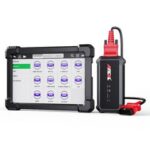Ford Diagnostic Software is essential for anyone who needs to diagnose and repair Ford, Lincoln, and Mercury vehicles. This software allows you to communicate with your vehicle’s computer systems to identify problems, perform tests, and even reprogram modules. Ford offers several diagnostic software options, each designed for different needs and vehicle models. Understanding these options is crucial for choosing the right tool for your diagnostic requirements.
Ford provides three main diagnostic software products: Integrated Diagnostic Software (IDS), Ford J2534 Diagnostic Software (FJDS), and Ford Diagnostic & Repair System (FDRS).
Integrated Diagnostic Software (IDS) is the traditional dealership-level diagnostic software for Ford vehicles from 1996 to select 2018 models. IDS offers comprehensive diagnostic coverage, allowing technicians to perform a wide range of functions, from reading trouble codes to conducting advanced system tests. To use IDS, you’ll need Ford diagnostic hardware such as VCM (Vehicle Communication Module), VCM II, or VCMM. A software license is required to activate IDS, granting access to the software, updates, and necessary calibration files for a specific period.
Ford J2534 Diagnostic Software (FJDS) serves two primary purposes. Firstly, it provides module reprogramming capabilities for 1996 to select 2018 Ford, Lincoln, and Mercury vehicles. Secondly, FJDS offers complete dealership-level diagnostics for Ford and Lincoln vehicles from 2018 to the present. FJDS is compatible with J2534 compliant Vehicle Communication Interfaces (VCIs), including Ford’s own VCM II and VCMM. Similar to IDS, FJDS requires a time-based software license for access, updates, and calibration files.
Ford Diagnostic & Repair System (FDRS) represents the next generation of Ford’s diagnostic software. Designed for use with VCM II, VCMM, and J2534 VCIs, FDRS delivers advanced diagnostic capabilities, particularly for newer Ford vehicles (some 2018 and forward models). FDRS is designed to be more user-friendly and offers enhanced diagnostic tools compared to IDS. Being cloud-based, FDRS ensures technicians always have the latest software version upon logging into the Ford network. Importantly, access to FDRS is included with either an IDS or FJDS software license, offering a comprehensive diagnostic solution.
Choosing the correct Ford diagnostic software depends on the vehicle you are working on and the tasks you need to perform. For older vehicles (1996 to select 2018), IDS is a robust choice for full diagnostics, while FJDS covers reprogramming and diagnostics for some newer models within this range. For newer Ford and Lincoln vehicles (2018 onwards), FJDS and FDRS are the primary options, with FDRS offering the most advanced features and user experience.
To get started with Ford diagnostic software, you will first need to download the software. Ford diagnostic software can be downloaded for free from the Motorcraft Service website. However, to fully utilize the software’s capabilities, purchasing a software license or activation key is necessary. This license unlocks the software and provides access to essential updates and calibration data, ensuring accurate and effective vehicle diagnostics and repairs. You can purchase a software license through the provided link on the Motorcraft Service website.
In conclusion, Ford diagnostic software is a vital tool for diagnosing and repairing Ford vehicles. Whether you choose IDS, FJDS, or FDRS, understanding the features and applications of each option will empower you to effectively maintain and repair Ford, Lincoln, and Mercury automobiles. Remember to obtain the necessary software license to unlock the full potential of your chosen Ford diagnostic software.
